Pisolithus arrhizus
It is late summer, when crumbly dog turds appear along the sidewalk, and we know that autumn is coming. Dog turds as harbingers of our favourite season!
In a time of year when there is not much moisture around, in the midst of our rainless California summer, these mushrooms are able to grow and form firm juicy fruitbodies. They are so firm, and have so much turgor that they can even push up the pavement and pop up in other unexpected places to shed their spores.
They do not get points for beauty. I remember a foray in Denmark into a dry sandy pine plantation where these weird fungi were sticking their heads up. Their ugliness was admired by all of us, but nobody wanted to be photographed with them...

Officially, the dog turd fungus is called Pisolithus arrhizus, one of many names for it. The name is derived from the Greek and means the ‘rootless pea-stone’. Dead man’s foot and Dye ball are two other common names for it. Older names for the genus include Polysaccum — the mushroom with the many bags. You’ll also find ‘tinctorius’ as its species name, referring to its qualities as a dye for wool — this has been known for a long time; Micheli mentioned it already in his book from 1729; can we assume that even in antiquity it was used as such? We can compliment all those mycologists in finding very suitable names for this species.
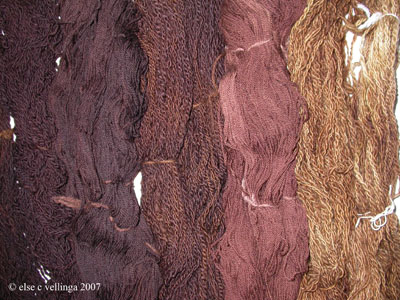
Pisolithus starts out as a club-shaped dark brown object, that when cut open shows those ‘peas’ — little compartments in which the spores are formed. Arora described them aptly as ‘rice crispies in tar’. In this stage, the mushroom is firm, wet, and stains our hands. In the next phase the top matures, the outer wall disintegrates and a dark chocolate brown dry spore mass is visible. Those spores are well suited for air transport — they have pigmented hydrophobic walls, and are spiny, real long-distance dispersers.
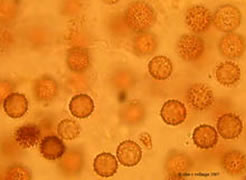 |
 |
The fruitbodies wither slowly and can, when not kicked, remain in place for months up to a year.
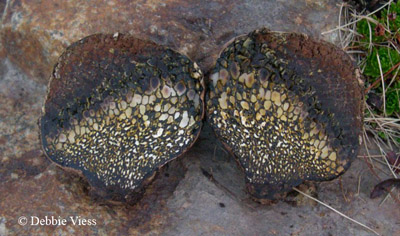
There is wide variation in the shape and size of the species – from round and small ones to humongous amorphous lumps. Do these forms represent different stages of one species or many species with each their own host?
Until very recently all the Pisolithuses found all over the world, were thought to be just one species, but molecular research has shown that there are at least eleven different types, and several species beside those eleven have been described. More work is needed to show whether these are all good species. Some of these molecular types are only found with one host plant species, e.g., Cistus, a shrub in the Mediterranean basin or with Afzelia in Africa. One part of the genus is exclusively Australian, growing with Eucalyptus and Acacia, but, now these species can be found far away from the place of origin, wherever Eucalyptus has been planted. Pisolithus albus is one of those Eucalyptus symbionts; it has been found in Spain, and probably occurs here in California as well.
British authors speculated that their local Pisolithus had been introduced with the planted Eucalyptus, but the Northern Hemisphere species P. arrhizus, the one we have here as well, does not associate with Eucalyptus. Most fungi mycorrhizal with Eucalyptus do not grow with other tree species at all. On the other hand, P. arrhizus can be found in the southern Hemisphere, growing with introduced pine species.
To the surprise of Australian researchers, Eucalyptus planted in China picked up a local species which formed partial ectomycorrhizae with the tree roots, but was detrimental to the growth of the trees. The whole point of planting the Eucalyptus there was to get fast a good crop of wood, so the newly planted trees would in future be inoculated with a different Pisolithus species to accomplish that.
Earthstars and puffballs in the genera Geastrum, Lycoperdon, and Bovista are saprotrophes, decomposing dead plant material, but Pisolithus is an ectomycorrhizal associate. Here in central coastal California it grows with coastal live oak, planted birch, cedars, Monterey pine and other pine species. A few autumns ago it popped up beside the European beech in our neighbor’s yard, a truly surprising host.
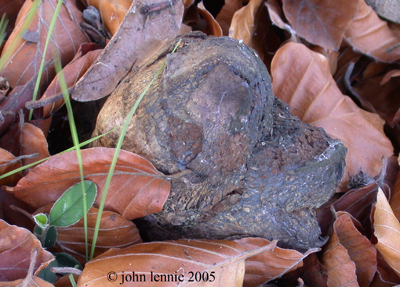
As already hinted at above, Pisolithus is widely used in initial inoculation of tree seedlings especially for forestry purposes. Here also different species are probably used, but the name given to the fungus is in most cases P. tinctorius. Paul Stamets’ Fungi Perfecti sells a mycorrhizal mix containing Pisolithus tinctorius (with four species of Rhizopogon). Pisolithus is ideal as it is so well adapted to drought. Mine tailings, dry sandy areas, restoration projects — Pisolithus will grow and help establish the young tree seedlings. Judging from the abundance of the species with full-grown trees here in California, it is also a good competitor which is not rapidly displaced by other fungal mutualists when the tree grows up.
Pisolithus arrhizus is very common here, both in the city, and in more natural habitats under oak. Many people who come to the fungus fair comment that it grows in their yard. In the northern Sierras and Lassen area it is common, especially in disturbed areas, in foothill woodland and open oak woods.
As the species fruits in those times of year that are too dry for others, it can easily be missed by ‘normal’ mushroom forays. So there is only one record in the NAMA voucher data base, from the 2000 foray in Newton, Texas. Fortunately, there are more herbarium specimens, and Grand reported that within the U.S.A. the species was found in 36 states, with most finds in the east, and in the western states. Many specimens grew in dry and disturbed areas, from open fields to sand dunes, sometimes without obvious tree hosts.
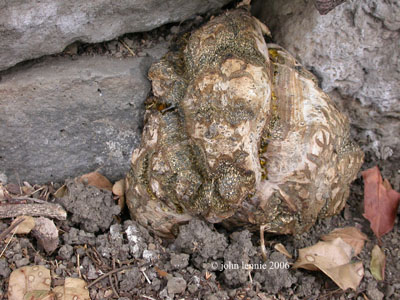
From its appearance it is not easy to guess the closest relative of our dog turd fungus. But, the presence of pulvinic acids and their derivates point in the direction of the boletes; these are the pigments that stain the wool. Molecular comparisons have confirmed that bolete connection. In a study by Binder and Bresinsky, Astraeus hygrometricus, another drought adapted ‘bolete’, is a sister group to Pisolithus. A bit further removed in the family tree are Scleroderma and real boletes like Gyroporus and the eastern Boletinellus merulioides.
Enjoy the presence of this species — autumn is on its way, and your tree has a useful partner on its roots!
Further reading:
- Binder, M. & A. Bresinsky, 2002. Derivation of a polymorphic lineage of Gasteromycetes from boletoid ancestors. Mycologia 94: 85-96.
- Grand, L.F., 1976. Distribution, plant associates and variation in basidiocarps of Pisolithus tinctorius in the United States. Mycologia 68: 672-678.
- Martin, F., J. Díez, B. Dell & C. Delaruelle, 2002. Phylogeography of the ectomycorrhizal Pisolithus species as inferred from nuclear ribosomal DNA ITS sequences. New Phytologist 153: 345-357.
© else c. vellinga 2007

 back to top
back to top